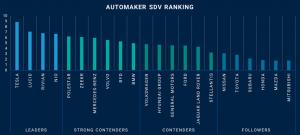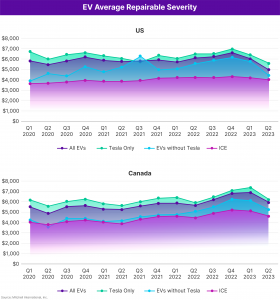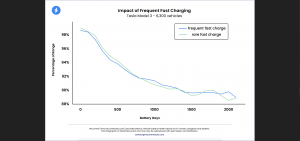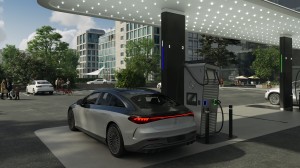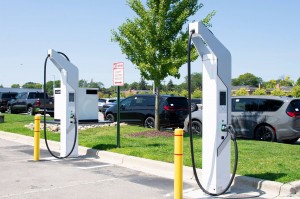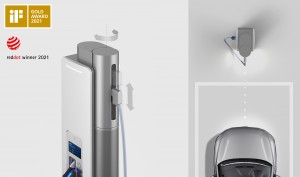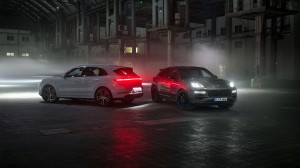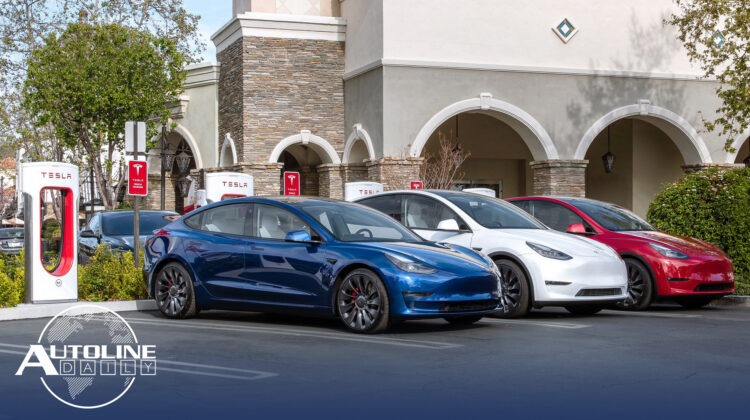

Follow us on social media:
Runtime: 11:11
0:00 Ranking OEMs by SDV Progress
1:37 Big $$ in EV Battery Recycling
2:35 EVs Cost More to Repair Than ICEs
3:22 Tesla EVs Not Hurt by Fast Charging
4:17 Mercedes About to Open Own Charging Network
5:00 Stellantis Expanding Dealer Charging Network
5:29 Hyundai to Build Fast Chargers In-House
5:54 Magna Takes Steps Now to Reach Net-Zero Later
7:22 Stereo Cameras Capture More Data Than Lidar
8:32 The Most Powerful Porsche Cayenne Ever
Visit our sponsors to thank them for their support of Autoline Daily: Bridgestone, Intrepid Control Systems, Schaeffler and Teijin.
This is Autoline Daily, the show dedicated to enthusiasts of the global automotive industry.
RANKING THE OEMS BY SDV
All the major OEMs have developed or are developing Software Defined Vehicles or SDVs, which allows practically any component or part to be controlled or manipulated by software. I think most people know that Tesla pioneered the concept, but Wards put together a fascinating list ranking 22 automakers on their transition to SDVs using 5 main categories; SDV strategy, connectivity, electrification, portfolio complexity and financial strength. And the top 4 “Leaders,” Tesla, Lucid, Rivian and NIO, which have already delivered Software Defined Vehicles, are all new EV companies. Other than Tesla, the question for them will be, can they reach scale? We find Wards description for the “Contenders” very interesting. This is where most of the mainstream brands fall. “OEMs yet to launch their next-generation platforms of semi-SDVs or that have set ambitious and potentially unattainable SDV timeline targets.” Ooh, that doesn’t sound too promising. But what we know of VW’s software division, called CARIAD, it’s pretty accurate. And also notice how every single one of the brands in the lowest “Followers” section is a Japanese automaker.
BIG $$$ IN RECYCLING EV BATTERIES
The recycling of EV batteries is still in its early days, but there’s growing global interest because it’s already profitable. NMC batteries or ones with nickel, manganese and cobalt, contain an average of $10,000 worth of materials for every ton of battery cell weight. LFP batteries – lithium iron phosphate – have about $4,000 worth of materials, according to a company called Fastmarkets that tracks commodity prices. S&P Global Commodity Insights is forecasting that battery recycling will provide 11% of all the lithium, 11% of the nickel and 44% of the cobalt needed to make new batteries by the end of this decade. Battery recycling companies like Cirba and Li-cycle have told Autoline that in a couple of decades, recycling could replace a significant amount of raw material mining.
EVs COST MORE TO REPAIR THAN ICE
It costs more to repair an EV than an ICE vehicle. That’s according to a new study from Mitchell International. In the second quarter of the year, EV repair costs were $963 higher on average than ICE vehicles in the U.S. In Canada, EVs are more than $1,300 more expensive to repair. And when you look at just Tesla, the costs jump to about $1,600 more in both countries. Part of the reason for the difference is that EV repairs require a lot more OEM parts, 90% for EVs compared to 66% for ICE vehicles.
TESLA BATTERIES BARELY DEGRADE WITH FAST CHARGING
Everybody knows that regularly fast charging your EV will kill the battery. Or will it? A company called Recurrent Auto compared Tesla Model Ys & 3s that fast charge at least 90% of the time to ones that fast charge less than 10%. While there’s clearly battery degradation over time, there’s shockingly little difference between fast and slow charging. Maybe 1-2%. But Tesla’s also do well because it has very good thermal, voltage, and battery management systems.
MERCEDES READY TO OPEN ITS OWN CHARGING NETWORK
There’s a lot of activity with EV charging to report on today. First up, Mercedes-Benz announced it will open the first hubs for its global EV charging network starting in October. They’ll be located in Atlanta in the U.S.; Chengdu, China; and Mannheim, Germany. By the end of next year, Mercedes is aiming to install 2,000 fast-charging points. And by the end of the decade, it plans to have 10,000 charging points located at 2,000 charging hubs globally. Depending on the region, the stations will offer a charging rate up to 400 kW and they’ll be open to all brands.
STELLANTIS EXPANDS DEALER CHARGING NETWORK
In the next bit of charging news, Stellantis announced it has partnered with Charge Enterprises to help build an EV charging network at its 2,600 plus dealers in the U.S. and provide them with end-to-end service. Stellantis has partnered with three other companies to provide similar services for its dealers and says these deals will help it reach its goal of hitting 50% BEV sales in the U.S. by the end of the decade.
HYUNDAI TO BUILD FAST CHARGERS IN-HOUSE
And to round out our EV charging news, an engine and transmission subsidiary of the Hyundai Group is developing EV fast chargers with proprietary technology that can put out up to 350-kW. Hyundai is trying to get them certified by the Korean government so it can deploy them at its charging stations in the country by the end of the year.
MAGNA’S IMMEDIATE STEPS TO REACH NET ZERO GOAL
Many companies are pledging to reach net zero carbon emissions by the middle of this century, including the supplier company Magna. But Magna is laying out its short term steps to reach its long term goal. For example, in Europe it will use 100% renewable electricity by 2025 and globally by 2030. It will cut about 42% of its 1 and 2 emissions, and about 25% of its scope 3 emissions by 2030. Scope 1 emissions are greenhouse gasses released directly by a business. Scope 2 emissions are indirect GHGs released from the energy bought by a company. And Scope 3 emissions are indirect GHG emissions that come from a company’s value chain, meaning from its suppliers. Magna’s director of Sustainability and Energy, Ahmed Elganzouri, tells Autoline that this year alone Magna will cut 10% of its energy usage by using waste heat from its manufacturing operations to warm its plants. It will also use automated building management to cut energy costs. It’s great to hear about all these net-zero pledges for 2050, but it’s more impressive to hear about the steps that are being taken today to get there.
STEREO CAMERAS CAPTURE MORE DATA THAN LIDAR
Maybe Elon Musk is right that using video cameras is better than lidar. A company called Nodar, which makes stereo vision video cameras, did a comparison test and came up with some interesting data. In one test at an automotive environmental chamber in Germany, it simulated driving on dark roads in heavy rain, violent rainstorms, and fog and the point cloud density from the high-resolution 3D cameras was 50 times greater than lidar’s. In night driving tests on roads in the Boston area, lidar generated about 1 million data points per second, while stereo vision cameras generated 40 million data points. And in tests for obstacle detection on dark roads at a closed airstrip in Maine, cameras detected a child-size mannequin from 200 meters away while lidar detected it from 100 meters. Now, we would expect a camera company to do tests that would favor its product over lidar. But even so, this is pretty interesting data.
THE MOST POWERFUL CAYENNE EVER
The all-new Porsche Cayenne debuted earlier this year and now it’s coming out with the Turbo PHEV version, which it says is the most powerful Cayenne ever. Its 4.0L twin-turbo V8 engine is paired with an electric motor that combines for nearly 545 kW or 730 horsepower. And it will do 0-60 in 3.5 seconds. The battery pack is up from about 18 kWh to nearly 26 kWh, which it says is enough to provide up to 82 kilometers or about 50 miles of range in the city. There’s a few styling cues that set the Turbo plug-in models apart from other Cayenne’s and like most Porsche’s there’s upgrades available for the suspension, brakes and interior. When it launches later this year, pricing in the U.S. will start around $148,500, while in Germany it will cost about 176,000 euros. And the Coupe version is available for about $5,000 more.
But that brings us to the end of today’s show. Thanks for making Autoline a part of your day.
Thanks to our partner for embedding Autoline Daily on its website: WardsAuto.com
Seamus and Sean McElroy cover the latest news in the automotive industry for Autoline Daily.




